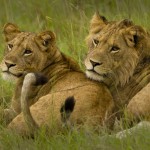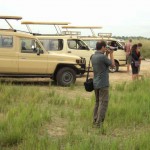
THE SETTLEMENT AND CLASSIFICATION OF THE PEOPLES OF UGANDA
GEOGRAPHICAL BACKGROUND.
Uganda lies entirely between the two arms of the Great Rift Valley in East Africa. To the west, Uganda a borders Zaire (former Belgian Congo). This border concides with the western Rift Valley occupied from north to south by Lakes Albert, Edward, George and Kivu. On this border with Zaire exit also, the Rwenzori mountain ranges, the highest point of which (Mt Margarita) is 5,119 meters high. Further south west between Lake Edward and lake Kivu ,there is the volcanic Muhabura range protruding from the rift Valley between 3,500 meters and 4,000 meters high.
In the north Uganda borders Sudan. The final demarcation of this border was fixed in 1914 giving Lado enclave to the Sudan and transferring West Nile from Belgian Congo to Uganda. To the east Uganda borders Kenya. Before 1902, the eastern boundary had extended as far as Lake Turkana. Gradual adjustments by the British who were ruling both Uganda and Kenya (then British East Africa) finally fixed the eastern boundary of Uganda in its present position in 1962.
To the south, Uganda borders Tanzania (former German East Africa). Boundary adjustments in 1910 between the British, the Belgians and the Germans fixed the southern limit of Uganda by including in Uganda, Kigezi which was formerly part of Belgian Congo and Bufumbira, formerly part of Germany East Africa.Kigezi was formerly part of Rwanda which together with Burundi and Tanganyika, formed German East Africa.
Generally, Uganda is a land of plateaus though in some areas there are hills which are 200 to 500 meters high. In most places, the hills ate heavily eroded. In the extreme west, the ancient tabular areas still remain.
The Equator crosses Southern Uganda and the climate is equatorial but moderated by the altitude. On the northern shores of Lake Victoria, it rains almost through out the year. In the rest of the country a dry season or two occur in the year. The highest temperatures occur on the Lake Albert flats while the lowest temperatures occur on the glaciated zone of Mt Rwenzori.
Much of Southern Uganda was formerly covered by equatorial forests but most of these have now been cleared for human settlement. This has occurred partially around Lake Victoria but some forests still exist on the Sese islands and in the Swampy zones between Lake Victoria, Lake Kioga, Lake Albert and the south of Lake Edward along the border with Zaire. In the higher regions, the vegetation groups its self in levels such that the thick vegetation forest with under growth of liana appears at the bottom on the lower slopes. Mountain forest extends to about 3,200 meters and above this; there are bamboo groves and airpine prairie.
THE SETTLEMENT OF UGANDA
The present country of Uganda was forged by the British between 1890 and 1926. The name of Uganda was derived from the ancient Kingdom of Buganda.
The earliest inhabitants of Uganda were the Stone -Age People. These people were gradually absorbed or replaced in the first millennium A.D. by the incoming agriculturists and pastoralists. At the time of the coming of the British, there were over thirty ethnic and cultural groups in Uganda. These ethnic communities could conveniently be divided into four broad linguistic categories namely; the Bantu, the Luo, the Atekerin and the Sudanic.
The Bantu occupy the Southern half of the country and, taken together, they constitute over 50 percent of Uganda’s total Population. They were the earliest group to come to Uganda and they Comprise; the Baganda, the Banyoro, the Basoga, The Banyankole, the Bakiga, the Bafumbira, the Batooro, the Bakonjo, the Bamba, the Batwa, the Banyole, the Basamia- Bagwe and the Baggwere. Generally they occupy the east, central, west, and southern Uganda.
The Second category is the Atekerin people. This group is variously referred to as the Para-Nilotics, the Lango or the Nilo- Hamites.These are found in the north, the east and north eastern Uganda. The group constitutes the Langi, the Karamajong, the iteso, the Kakwa and the Kumam. They trace their origins to Ethiopia and are said to have been one people. Through migrations, they came to settle in different parts of Uganda and they have developed particular characteristics which tend to distinguish them from one another. For instance, the Langi lost their Ateker language and culture and spoke Lwo.
The final category is the Sudanic speakers of West Nile. This group comprises the Madi, the Lugbara, the Okebu, the Bari, and the Metu. They trace their origin to the Sudan but their cultures and language indicate that they have become completely detached from their places of origin. With the Coming of colonialism, the Lugbara tended to dominate other groups as the Lugbara language and culture was encouraged in all primary schools as a medium of instruction.
At present it is difficult to demarcate the confines of any one of the ethnicities described above. Colonialism, education, mineralization, easy transport and urbanization have led to the break up or at least the loosening of cultural ties thereby leading to intermarriages and intermixtures which make it difficult to categorize, let alone demarcate the confines of different ethnicities of Uganda. However, culture ties still bind people and though intermixing has happened on a large scale since colonialism, intermarriage is not very common and people still prefer to identify themselves by their different ethinic backgrounds. This has been the cornerstone of tribalism in post-colonial Uganda.
THE EARLIEST MAN CREATURE
The direct ancestor of modern man is said to have been Homo habili. This creature is said to have had the knowledge of making and using tools. He is thought to have been contemporaneous withAustralopithecines, the first creature to walk on two legs. Traces of these most ancient human creatures in Uganda were found in Rusinga and Moroto. The type of creature identified at these sites was Dryopithecus. It was partially bipedal creature said to gave existed as far back as between thirty and fifteen million years ago.
STONE-AGE MAN
The earliest man in Uganda lived around 60,000-50,000 B.C. This was the early Stone Age man known as Homo erectus.Traces ofHumo erectus in Uganda were found at Nsongezi. He had the knowledge of making and using stone tools, especially the hand axe. Between 50,000 and 150,000 B.C, there emerged the middle Stone – Age man. During this period, man invented fire and more stone tools and began to become widely distributed. In Uganda, sites of the Middle Stone – Age man can be traced at Nsongezi and Sango Bay.
The development of the present man is said to have taken place during the period 10,000 to 1,500 B.C. This falls within the Late Stone – Age period which is said to have lasted between some five hundred to six hundred years but traces of which still exist in most African societies. Between A.D. 500 and 1,500, other people began to migrate to Uganda from different parts of Africa. The first and largest group of such people was the Bantu. The earliest surviving inhabitants the Bantu found in Uganda are the pygmaean, Batwa and the Bambuti.
THE CLASSIFICATION OF UGANDA PEOPLE AND THEIR CULTURE:
THE BANTU: The Bantu are a group of people who speak related languages and have similar social and cultural characteristics. More on the bantu>>>
THE NILOTICS: The Nilotics group is another extensive family all over east Africa. They can be divided into the highland Nilotics and the plain Nilotics which in Uganda include; the Nilo Hamites (the karamajong, the Iteso, the Kumam and the Langi), the river lake Nilotics (the Alur, the Acholi and the Japadhola). In Uganda, the river-lake Nilotics can be described as the Luo.

 Posted in
Posted in 

